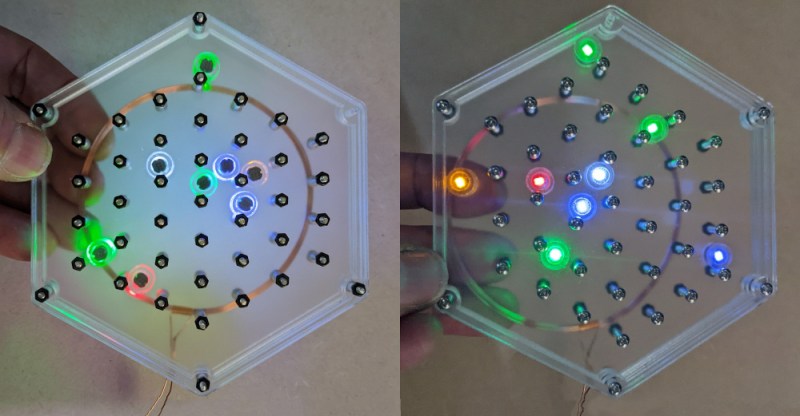Imagine if you had some magic glowing beads, that would emit beautiful colors without any wires tangling them up. They exist, in the form of wireless induction-powered LEDs, and [Debra] of Geek Mom Projects has been experimenting with them in a new way.
The build takes the wireless LEDs and wraps each one up in a 1/4″-thick clear ring of acrylic. This toughens up the LEDs and helps diffuse their light. They’re then installed in a hexagonal plastic container, featuring a grid of screws not unlike the metal pins of the game Plinko. Thanks to the induction coil mounted behind, the LEDs glow as they ricochet around the metal pins in various ways.
We’d love to see the container full of LEDs mounted on a slowly-turning motor, such that they would tumble around endlessly, glowing all the while. It would be quite mesmerizing, in much the same way as the kaleidoscope project [Debra] built using these parts previously. Video after the break.
New wireless (induction powered) LED experiment. Each LED assembly is housed inside a 1/4" thick clear acrylic ring. I like the way these thicker rings diffuse the colored light. pic.twitter.com/0cevJGxHjz
— Geek Mom Projects (@geekmomprojects@qoto.org) (@GeekMomProjects) April 18, 2022
[Thanks to Peter Martin for the tip!]
















I wonder if it would be possible to have an LC circuit tuned for a different frequency in each LED, so you could switch them off by sending in a different AC frequency.
It looks like there is enough space on the back of those LEDs to fit one of those match head M0 MCUs as seen on these pages recently – I wonder if they could be upgraded to be RGB and addressable with some modification of the two wire protocol as a modulation to the main induction coil frequency?
It’s not terribly difficult to have each LED with its own tuning and modulate with multiple frequencies at the same time.
Perhaps it might be possible to have programmable/addressable wireless LEDs, perhaps using different frequencies for power and data.
Something similar to RFID maybe.
There is something very pleasing about seeing those little dots of light moving around. Nice!
Would be interested to understand its application / how it could be used
Anybody know how the shape of the transmitter coil affects power transmission? My mind immediately went to costumes/cosplay-type things where I could attach glowy bits to clothing without wires. Could I put a big retangular or oval coil down my sleeve, for example, and get good-enough power transfer to make the LEDs glow? The last time I did any inductance/EMF math was in high school.
It’s been a long time since I did the math, but the power delivered by the magnetic flux is a function of the area within the coil, the number of windings, and the current going through the coil. It turns into calculus real quick if you want exact values so you’re best off experimenting with different coil configurations to see if they’re good enough.
Rectangular coils are definitely feasible and are use in commercial products. You could also do a series of smaller coils. For a sleeve, I’d try a rectangular coil on each side of the bicep and forearm, front and back.
Unless the coils are exactly circular and exactly parallel, this is a very inefficient way of delivering power, though. It is definitely feasible and your idea for cosplay wearables sounds brilliant, though!
That’s a cool idea. Will it work if the coil is wound along a hex corner? I was wondering if there is a way to make the coil invisible.